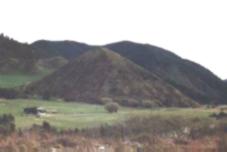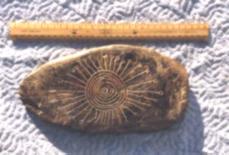Pyramids In The Pacific

The Unwritten History Of Australia
Chapter 7
|
Egyptian and Phoenician Miners Explore the Pacific |
"Now to all ships the deep is free; The limit of man's sway expands
New ramparts in their majesty Arise in younger lands.
In the broad world the ancient ways; No longer can our steps confine:
The Indian by Araxes strays, The Persian drinks the Rhine.
An age will come in later years When Ocean's stream no more shall be
Earth's boundary, when land appears
Beyond the utmost sea.
New realms before the steersman shall extend:
The world shall be a world without an end.
Medea;
Seneca, Ist century BC.
|
Chapter
7 Images
|

|
New Zealand Pyramid Mountain
Photo Rex Gilroy
Long before the age of the Pharaohs saw mighty edifices raised along the banks of the Nile, stone-age societies had long relied upon the river for their sustenance, for fish, fowl and other wildlife were in abundance here. Then around 5200 BC, these people abandoned their primitive hunter-gatherer existence, in the wake of the arrival of bands of settlers from the Fertile Crescent.
Principally Sumerians, they bought with them the wheeled cart, livestock, domestic strains of wheat and barley, and the Sumerian system of writing. They influenced irrigation techniques, which led to the diverting of the Nile's floodwaters into canals and catchments, which aided agriculture, the development of communities and the beginning of trade between them.
From the beginning, the fertile countryside along the Nile was divided naturally into two regions; Upper Egypt, comprising the narrow river valley extending northwards from around Aswan; and Lower Egypt, being the marshy country of the Nile Delta. Then, in the year 3200 BC, there arose a god-king, Menes, founder of the 1st Dynasty, who united Upper and Lower Egypt into a single kingdom. Soon Egyptian merchants were pursuing foreign trade, and despite shifts in lineage occasioned by the absence of heirs, and wars, the nation would rise to become the greatest civilisation of the Old World after Sumer.
Thirty dynasties would come before Egypt fell to Alexander the Great in 332 BC, ushering in the rule of the Ptolemies {332-30 BC}, which was followed in turn by the Roman occupation of 30 BC-395 AD; and the Byzantine rule from 395-638 AD, by which time the glory of the Pharaohs was but a dim memory. In the hope thier remains would last through eternity, the 1st dynasty Pharaohs had large mud brick tombs built for them in the Upper Egyptian town of Abydos, which would become the centre of the Osiris {nature god} cult.
These tombs were called mastabas and contained rooms in which were stacked tomb offerings of food, furniture, tools and weapons for the Pharaohs' use in the next life...The tombs of the Pharaohs underwent a radical change in the 3rd dynasty, about 2659 BC when King Djoser, founder of the dynasty, commissioned the building of a tomb that would reach the sky. This form of pyramid would be followed by the more familiar straight-sided examples of later Pharaohs. Mummification of the dead began around the beginning of the 4th dynasty about 2600 BC. The embalmers would first remove the dead Pharaohs' internal organs by an incision in the abdomen, these being placed in a Canopic jar, a vessel filled with natron.
They then dried the body cavity and packed it with resin-soaked linen before preparing the exterior, which might include the applying the face with green paint and placing jewellery and elegant robes on the shrouded corpse. The spread of the Djoser style step pyramid beyond the Nile can be seen in similar stone structures in south-east Asia, Australia and certain West Pacific Islands, always in the vicinity of precious metal deposits and nearby remains of ancient colonisation; which suggests that, Egyptian mining fleets were present hereabouts not long after the development of the Djser step pyramid.
As early as 3000 BC Egyptian vessels had ventured down the African east coast to Somaliland, which they named 'Punt' and about 2400 BC they sailed down the west coast to reach this country by rounding the "Horn", where they found gold. As I have stated elsewhere, the name 'Punt' would also be used to describe the mysterious southern continent, also to be known as Kenti-Amenti, the fabled "Land of the Gods".
|
Pyramids
in the Pacific Images
Ch 7
|

|
Sacred Aboriginal Tjuringa Stone